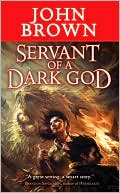by John D. Brown
 The following is part of a continuing series. If you wish to start at the beginning, head to It’s All About The Reader.
The following is part of a continuing series. If you wish to start at the beginning, head to It’s All About The Reader.
In my last two posts, I identified a number of things that make people and, therefore, characters interesting to us. In this post, I’ll present the last two draws and introduce the next condition for reader suspense.
Surprise
We are intrigued by characters who play against type, even if it’s only a little. So maybe you have a plumber who quotes Shakespeare or William Blake to his customers. Maybe you have a mixed martial arts fighter who is a woman with three kids. Maybe the hero hates dogs. Maybe he’s a bee keeper. Maybe the villain has a fear of spiders or tends lovingly to his daughter. Maybe the cutthroat millionaire businessman secretly goes to poor neighborhoods to find folks to help. Maybe the bearded and tattooed biker carries around a Book of Mormon and reads it during quiet moments. Maybe, like Michael in the series Burn Notice, the super spy loves yogurt. Anything that runs against, or just doesn’t fit, our expectations of the type. This includes motives as well as external character tags.
Cast Variety
Finally, because we almost always deal with a cast of people in our stories, we need to make sure they’re interesting as a group. You will increase reader interest if you give each character some memorable and interesting trait, but you’ll get the most bang for the buck if you make those traits different.
For example, let’s say you have a team of characters who need to go behind enemy lines to find and dismantle a radar station. If every one of those team members is exactly the same–they’re all wise-cracking blond farm boys from Oklahoma–we might find it funny and odd at first, but it will soon lose its appeal as they all say and do the same things.
Compare this to a group where one is a silent-but-deadly farmer, another is a metaphysical mechanic, a third is a short woman’s man, the fourth is a wise-cracking American Indian. Maybe one joined the ARMY because he’s got first person shooter games dancing in his eyes, another because his father was a military man, another is there to conduct some kind of criminal heist, the fourth because he’s poor and needed help getting through college and supporting his wife and kid.
I know, I know, you women are probably saying the tall blond farm boys might not be all that bad. But after you finish ogling them, think of this: your readers might not all be farm boy types.
Did you ever wonder why boy bands have a variety of types–the serious one, the good one, the bad one, the cutie? It’s because it broadens the appeal to a wider audience.
But it goes beyond that. Variety also avoids the problem of diminishing marginal utility. This is simply the idea that the more you experience something, the less power each experience provides. For example, the first time you hear a great joke it may be gut-busting funny. By the time you’ve heard it twenty times the joke makes you want to rise up and swat the teller. Imagine eating a meal that’s nothing but salmon or broccoli or fried okra or ice cream. Eventually, after twenty dishes of cheese, you will go blind. The same thing occurs with characters. This is why it’s always more powerful to have one villain instead of a hundred of them. One wise-cracking American Indian is awesome. Fifteen of them only water down the effect so that none of them are as powerful as the one could be all by herself.
And it doesn’t end there. There’s an even more important reason for giving your cast variety: it opens up possibility for more conflict, surprise, and story. Maybe one of the lead’s team members turns traitor. Maybe one of the bad guys is thinking about doing his boss in. With some variety, you can not only write about the main problem, but you also add in subplots–a love story or a redemption plot. And both can complicate the central problem.
Variety adds interest. Develop your characters–the major, minor, and bit roles, folks that help our leads and others who hinder or oppose them–but also develop them with an eye towards the effect of the cast as a whole.
Characters you want to hope and fear for
So this brings us to the end of the ten things that I think make characters interesting.
1. Power
2. Ability
3. Extraordinariness
4. Beauty
5. Wish-fulfillment
6. Humor
7. Danger
8. Secrets
9. Surprise
10. Cast variety
You, of course, may disagree. So I suggest you take a few moments and make your own list. I guarantee it will be worth your time. Heck, post your ideas in the comments.
Now let’s take a step back and look at what’s been discussed to this point. Our readers want to hope and fear for our characters. They want to feel sympathy. But they also want to be delighted and awed by them. They want to feel admiration for them. They want to laugh at and with them. These are some of the key joys of the experience they come to us for.
The way we deliver this is by giving our characters problems that are hard to solve. We can add other troubles and let them demonstrate they deserve to be rooted for. We also make sure they’re interesting.
But we’re not done yet. Right now we’ve only talked about the problem and the character. That’s just the beginning. Remember, readers want to hope and fear and then feel a cathartic release. But you can’t feel catharsis if your worries don’t have time to build.
Form follows function.
Think about the itch deep down in your cast that builds and builds and builds over days. It’s amazing when you finally scratch it. Think about the time you couldn’t drink or eat for a day or two and how hungry or thirsty you were. Think about how good it felt to finally satisfy that tension. The experience of eating after a fast is completely different from the one when you eat when you’re still mostly full.
You need to make your readers hungry for a release. They want to be hungry. And building that hunger takes time. So while a six-hundred word piece of flash fiction can evoke some emotion, it’s nothing compared to the emotion and experience a 100,000 word novel can deliver. Because 100,000 word novels allow you to build the reader’s hunger, their tension, their hope and fear, to a sharp point.
You build this tension with plot. And that will be what I discuss in the next in a number of posts.
In the meantime, if you think of other things that make characters interesting or sympathetic, specific examples of the factors I’ve talked about, or have questions, please post them in the comments.
More great reading
Many of the factors listed above that make characters interesting have to do with them being larger than life. If you want to read more on this, Orson Scott Card devotes a whole chapter to it in his wonderful book Characters & Viewpoint.
For those interested in exploring the factors that lead to sympathy, let me recommend Adam Smith’s The Theory of Moral Sentiments. That link will take you the wiki about the book. At the bottom of that wiki are links to the actual text.
Finally, I know some of you might be thinking that you’ve actually rooted for bad guys. This seems to contradict what I said about deservingness. But it really doesn’t. Read “Villainous Heroes” to see what I’m talking about. Next read “What Makes a Great Villain?” and “The Main Thing About Villains.” Then come back here and let us know if the apparent contradiction hasn’t been resolved.
Happiness,
John
—
 John Brown is an award-winning novelist and short story writer. Servant of a Dark God, the first book in his epic fantasy series, was published by Tor Books and is now out in paperback. Forthcoming novels in the series include Curse of a Dark God and Dark God’s Glory. He currently lives with his wife and four daughters in the hinterlands of Utah where one encounters much fresh air, many good-hearted ranchers, and an occasional wolf.
John Brown is an award-winning novelist and short story writer. Servant of a Dark God, the first book in his epic fantasy series, was published by Tor Books and is now out in paperback. Forthcoming novels in the series include Curse of a Dark God and Dark God’s Glory. He currently lives with his wife and four daughters in the hinterlands of Utah where one encounters much fresh air, many good-hearted ranchers, and an occasional wolf.
For a list of all of the posts in this series thus far, click on the “John D. Brown” tag.
